
Ammonoids are a group of extinct marine mollusc animals in the subclass Ammonoidea of the class Cephalopoda. These molluscs, commonly referred to as ammonites, are more closely related to living coleoids than they are to shelled nautiloids such as the living Nautilus species. The earliest ammonites appeared during the Devonian, and the last species either vanished in the Cretaceous–Paleogene extinction event, or shortly after during the Danian epoch of the Paleocene.
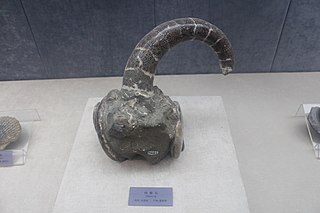
Hamites is a genus of heteromorph ammonite that evolved late in the Aptian stage of the Early Cretaceous and lasted into the Cenomanian stage of the Late Cretaceous. The genus is almost certainly paraphyletic but remains in wide use as a "catch all" for heteromorph ammonites of the superfamily Turrilitoidea that do not neatly fit into the more derived groupings. In an attempt to identify clades within the genus, it has been divided up into a series of new genera or subgenera by different palaeontologists, including Eohamites, Hamitella, Helicohamites, Lytohamites, Planohamites, Psilohamites, and Sziveshamites.
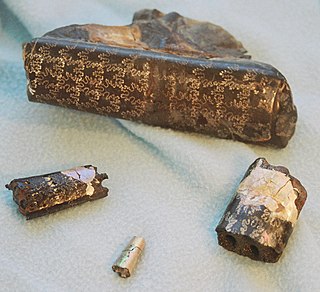
Baculites is an extinct genus of cephalopods with a nearly straight shell, included in the heteromorph ammonites. The genus, which lived worldwide throughout most of the Late Cretaceous, and which briefly survived the K-Pg mass extinction event, was named by Lamarck in 1799.
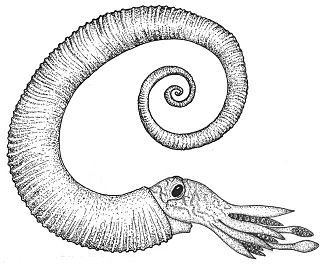
The Ancyloceratina were a diverse suborder of ammonite most closely related to the ammonites of order Lytoceratina. They evolved during the Late Jurassic but were not very common until the Cretaceous period, when they rapidly diversified and became one of the most distinctive components of Cretaceous marine faunas. They have been recorded from every continent and many are used as zonal or index fossils. The most distinctive feature of the majority of the Ancyloceratina is the tendency for most of them to have shells that are not regular spirals like most other ammonites. These irregularly-coiled ammonites are called heteromorph ammonites, in contrast to regularly coiled ammonites, which are called homomorph ammonites.

The Turonian is, in the ICS' geologic timescale, the second age in the Late Cretaceous Epoch, or a stage in the Upper Cretaceous Series. It spans the time between 93.9 ± 0.8 Ma and 89.8 ± 1 Ma. The Turonian is preceded by the Cenomanian Stage and underlies the Coniacian Stage.

Ancyloceras is an extinct genus of heteromorph ammonites found throughout the world during the Lower Cretaceous, from the Lower Barremian epoch until the genus extinction during the Lower Aptian.
Anaklinoceras is a genus of extinct heteromorph ammonite cephalopod that lived in marine environments in what is now Western North America during the Campanian division of the Cretaceous period. Their shells were very similar to the related ammonites of the genus Ainoceras, where the young ammonite's shell coiled helically, and upon reaching adulthood, the youngest coil arched over the older coils.

Annuloceras is an extinct genus of ammonite cephalopod. Its fossils are found in Lower Barremian sediments from California. The genus is currently placed in the family Aegocrioceratidae.
Anisoceratidae is an extinct family of heteromorph ammonites which belong to the Ancyloceratina superfamily Turrilitoidea. Members of the family range is from the lower Albian to the upper Turonian. The family is possibly derived from a member of the Hamitidae.

Nostoceratidae is a diverse family of heteromorph ammonites found throughout the oceans of the world during the Late Cretaceous. The nostoceratids are famous for the bizarre coiling of their shells. Many genera, such as Yezoceras, Ainoceras, Anaklinoceras, and some species of Bostrychoceras and Eubostrychoceras, display, as young shells at least, a helical coiling very similar to the shells of the related family, Turrilitidae. As adults, though, the coils then curve away from the axis of coiling, either as an oxbow-like curve around the juvenile coils as in Ainoceras and Anaklinoceras, or in a simple curved loop beneath the juvenile coils, as in Yezoceras. Other genera form loose coils, sometimes in a spiral, such as those of Madagascarites, Muramotoceras, Hyphantoceras, and the infamously convolute Nipponites.

Nipponites is an extinct genus of heteromorph ammonites. The shells of Nipponites form "ox-bow" bends, resulting in some of the most bizarre shapes seen among ammonites.
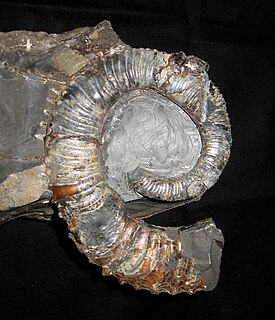
Exiteloceras is an ammonite genus from the Late Cretaceous.

Nostoceras is an extinct genus of ammonites. The etymology of the name Nostoceras comes from "nostos" meaning return and "ceros" meaning horn, named as such by Alpheus Hyatt because it bends back on itself.

Collignociceras is a strongly ribbed and tuberculate, evolute ammonite from the Turonian of the western U.S. and Europe belonging to the ammonitid family Collignoniceratidae. The genus is named after the French paleontologist Maurice Collignon. The type is Collignoniceras woollgari, named by Mantell in 1822 for specimens from Sussex, England.
Neoptychites is an extinct ammonoid cephalopod genus from the Turonian stage of the Upper Cretaceous, with a worldwide distribution.
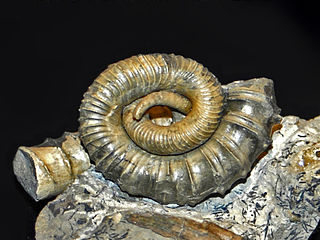
Muramotoceras was an unusual genus of heteromorphic ammonite. It was known only from Japan until researchers reported in 2001 that the genus was present in Alaska's Matanuska Formation as well. Its remains likely date to the middle Turonian in both areas.
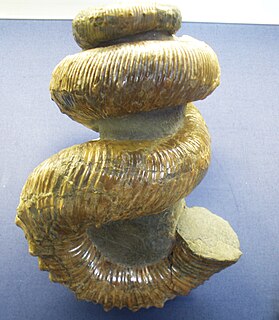
Didymoceras nebrascense was an extinct species of heteromorph ammonite from the upper Campanian age. It was sexually dimorphic, with two adult sizes averaging at 270 mm (11 in) and 180 mm (7.1 in) high for females and males respectively. It exhibited three distinct growth stages. The first growth stage was composed of one or two straight sharply bending sections and a gently curved third. The second growth stage is composed of around three and a half loosely coiling whorls. The last (adult) growth stage is composed of a U-shaped bend facing upwards.

Macroscaphites is an extinct cephalopod genus included in the Ammonoidea that lived during the Barremian and Aptian stages of the Early Cretaceous. Its fossils have been found throughout most of Europe and North Africa.

Pachydesmoceras is a genus of ammonites belonging to the family Desmoceratidae.

Calycoceras is an extinct genus of cephalopods belonging to the subclass Ammonoidea and family Acanthoceratidae that lived during the Cenomanian stage of the Late Cretaceous, 100-94 Mya. Their shells had ornate ribs.















